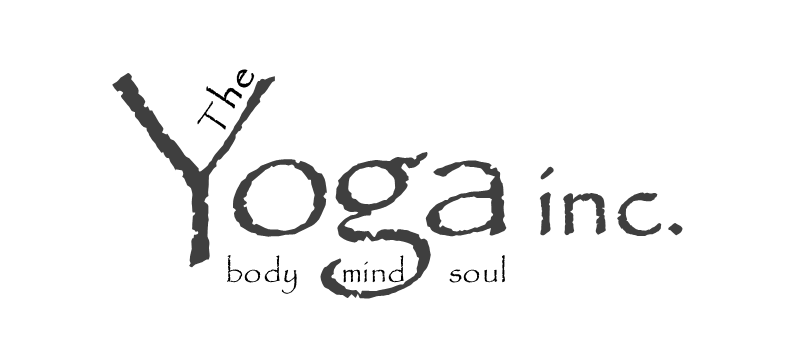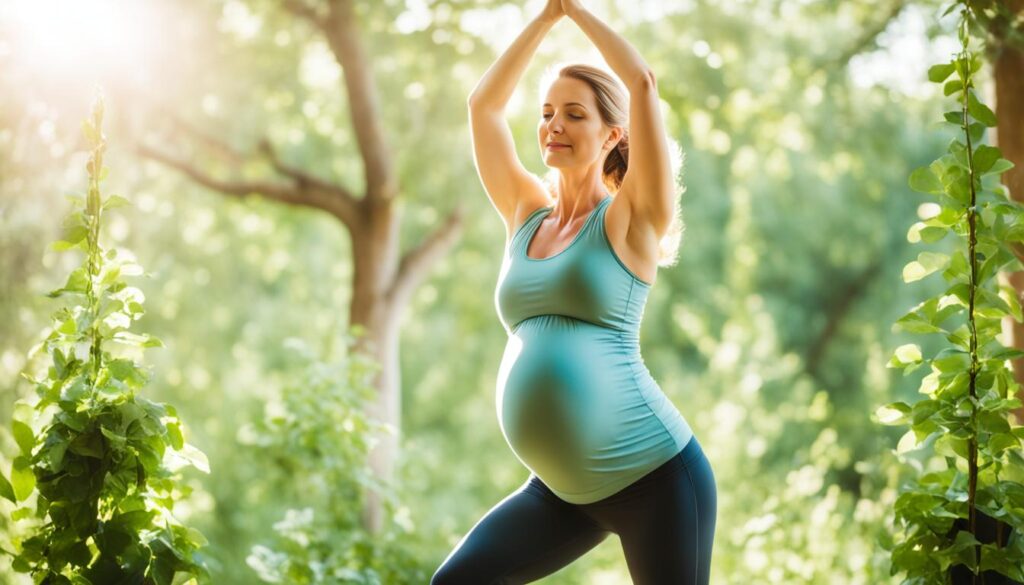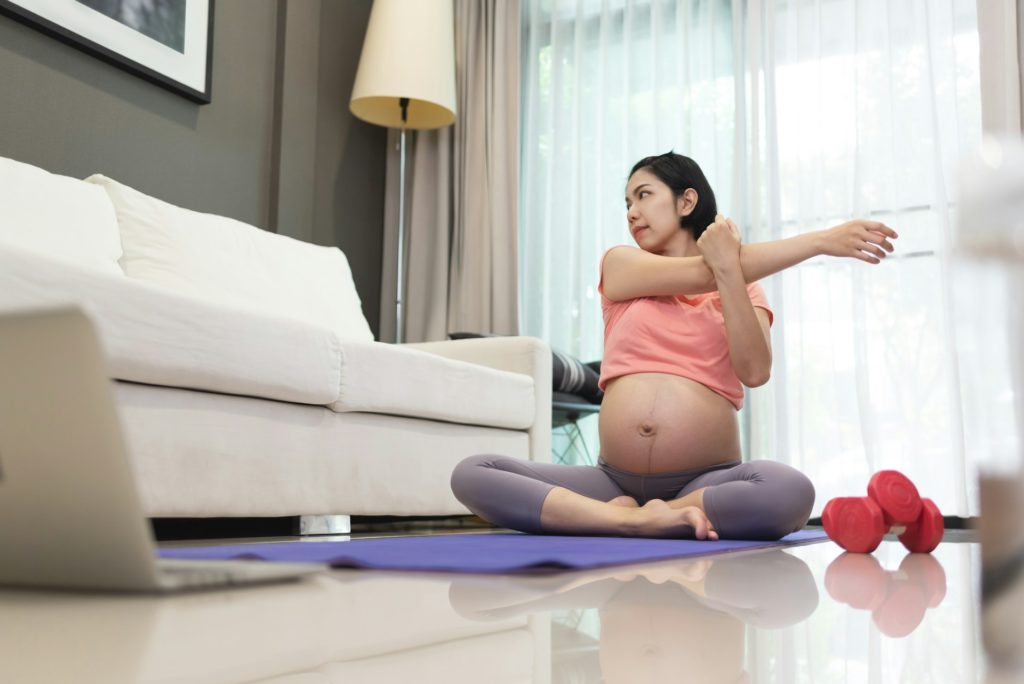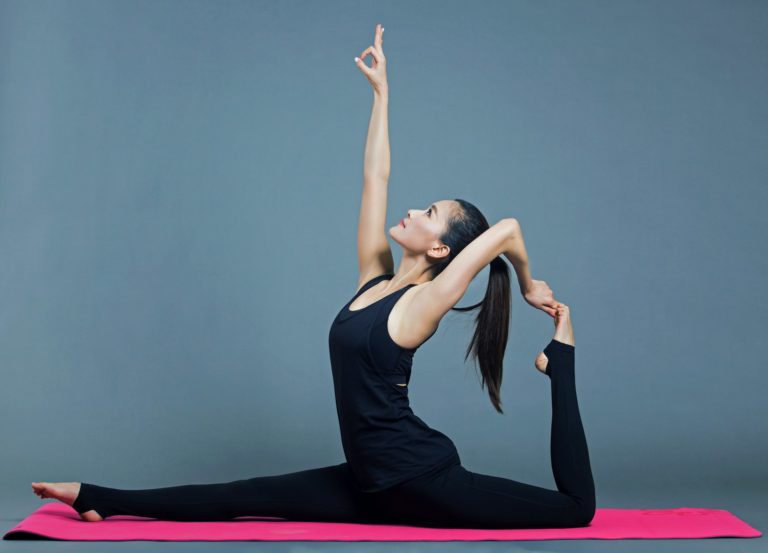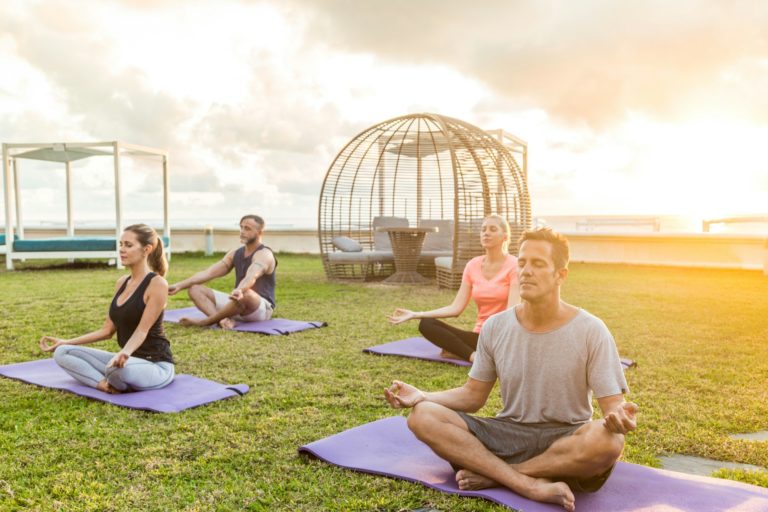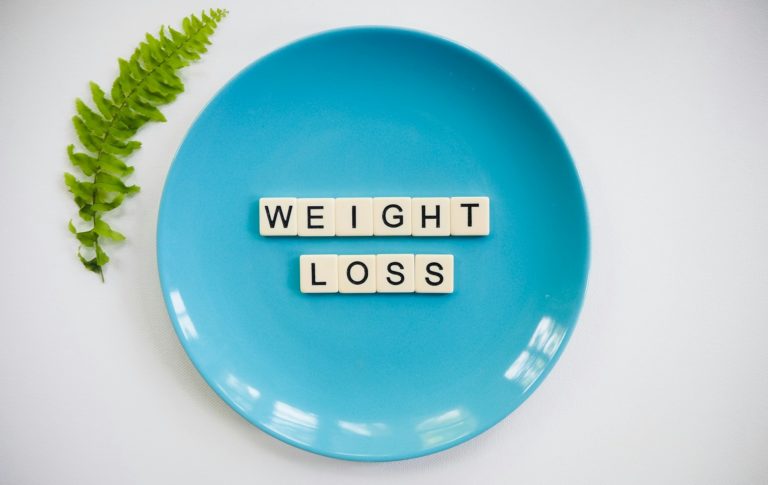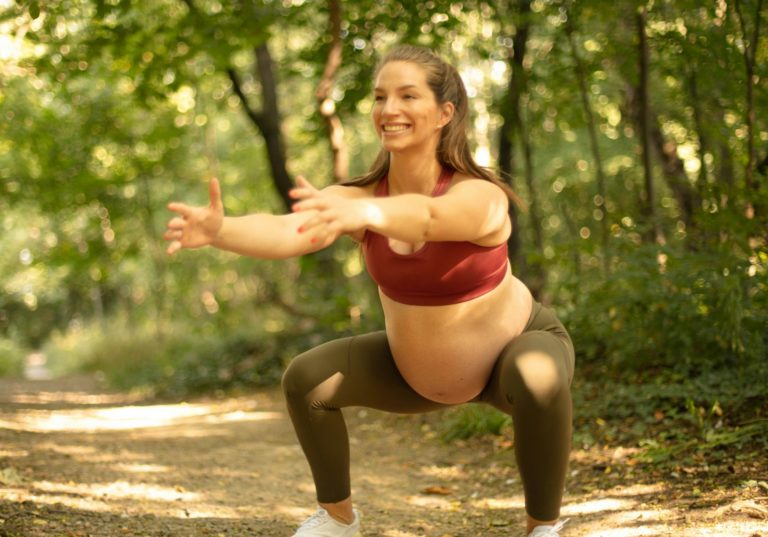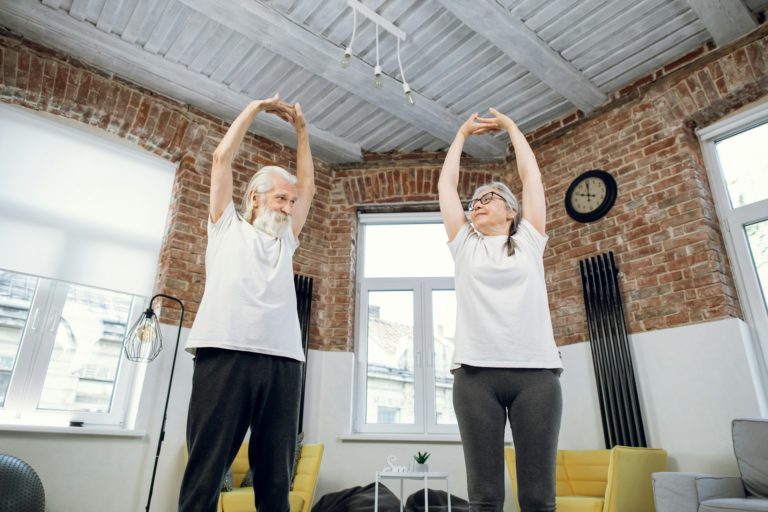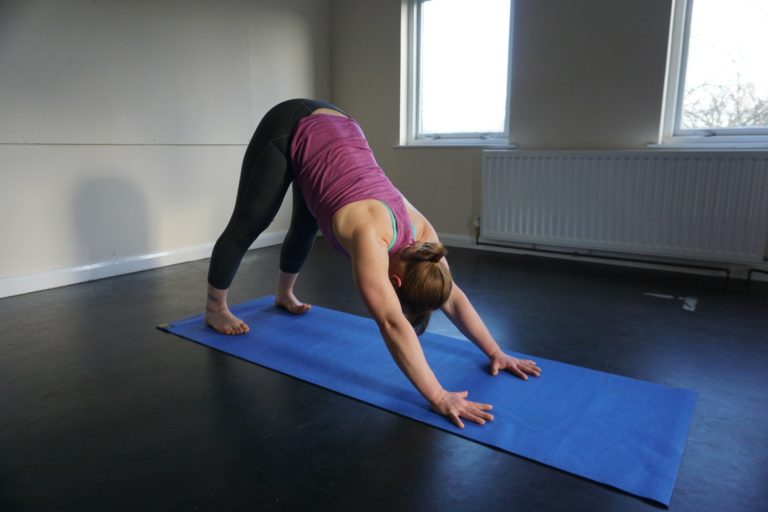Safe Yoga for Pregnant Women | Prenatal Peace
Did you know that being active during pregnancy can help with many symptoms? According to ACOG, practicing yoga during pregnancy can help with constipation, back pain, and healthy weight gain. Expecting moms like me to find a lot of good in prenatal yoga. It’s a gentle way to stay active, reduce stress, sleep better, and feel less uncomfortable.
Prenatal yoga can improve heart function and lower blood pressure, preventing preterm labor and high blood pressure during pregnancy. Doing yoga daily has brought me peace and strength, and I feel more prepared to be a mom.
This image shows a pregnant woman in a tree pose, with her hands above her head, connected to nature. The background is green, sunny, and peaceful. Her baby bump is visible, but she looks strong and confident in her practice.
I never knew so much about prenatal yoga. Prenatal yoga with meditation and breathing reduces depression in pregnant women. It might also make the prenatal period and labor easier. How cool is it that prenatal yoga affects both moms and babies?
I try to be active daily, and prenatal yoga is my go-to. But it would be best if you did yoga for each of the three months of pregnancy. Always talk to your doctor before starting prenatal yoga, especially if you have health issues or concerns. I’m taking care of myself and my mind with safe yoga.
Takeaways
- Prenatal yoga is a gentle and safe practice for pregnant women to reduce stress, sleep better, and feel less uncomfortable.
- Studies show that prenatal yoga can lower arterial pressure and heart rate, prevent preterm labor, and reduce depression in pregnant women.
- Prenatal yoga practice can help with weight gain during the prenatal period and more comfortable labor and delivery.
- Prenatal yoga guidelines for each trimester are important; consult a doctor before starting any new routine.
- Safe prenatal yoga for pregnancy takes care of the physical being and mind during this period.
Prenatal Yoga Class for Expecting Moms
Physical activity through prenatal yoga has been a big help for me as an expecting mom. It’s gentle but powerful, tackling physical and emotional challenges. As we moms-to-be know, pregnancy can be tricky. Prenatal yoga is a space to stretch, strengthen, and better understand our bodies.
This type of yoga is for pregnant women. It keeps us safe while we try to be flexible and strong. It uses breathing and stretching to ease pregnancy discomforts. And it helps our minds, too.
Stress, Anxiety, and Depression During Pregnancy
Prenatal yoga is fantastic for reducing pain, anxiety, and depression and improving mental health. Research on pregnancy yoga interventions has shown significant benefits in reducing stress, anxiety, and depression during the prenatal period. Studies show it can reduce complications and stress. It might even reduce the chances of having a small baby.
Mindfulness in prenatal yoga helps us find peace and better understand ourselves. Focusing on our breath and body releases tension, calms the heart, and relaxes. It also reduces pain and feels good.
Yoga Helps Sleep and Lower Back Pain
Many pregnant women struggle with sleep and back pain, but practicing prenatal yoga regularly can solve these problems naturally. After practice, our bodies can sleep better and rest more.
Some yoga poses are good for back pain and balance. These exercises keep our muscles strong and prepare us to recover faster after giving birth.
Social Bonding among Pregnant Women
Joining a prenatal yoga class is not just about physical activity. It’s a chance to meet other moms to combat the loneliness of pregnancy. Talking to women who understand makes us feel supported and strong.
A prenatal yoga class helped me build a support system and pregnancy and childbirth becomes less scary and more manageable.
A prenatal yoga class is a space to share tips and excitement. We encourage each other through all stages of pregnancy. The friendships formed in these classes last beyond pregnancy. They will still support us even after our babies are born.
First Trimester Yoga: Guidelines and Safety Reminder
I’m an expecting mom in my first trimester and love pregnancy yoga. For me, it’s all about making sure my practice is pregnancy-safe. I take a few precautions and avoid certain poses to protect my baby and me. Practicing yoga safely during the first trimester is essential to protect both the mother and the baby.
In my first trimester, I will avoid yoga poses that can harm my baby bump, such as deep backbends, twists, or intense stretches. I will also avoid poses that require strong stomach muscles. And I will say no to going upside down unless a pro watches over me.
Poses to Practice and Avoid in the First Trimester
I will focus on poses that are good for my prenatal period. These help me relax and stay balanced. Some pose I like:
- Vrksasana (Tree Pose) for balance and strength
- Malasana (Garland Pose or Squat) for hip and pelvic floor strength
- Lunges for spine elongation and hip stretching
- Supported Paschimottanasana (Seated Forward Bend) for gentle stretching and relaxation
- Supported Supta Baddha Konasana (Supported Reclined Bound Angle Pose) for relaxation and stress relief
I will also avoid some poses. They will not do these poses if you find a good pregnancy yoga class. These are risky or uncomfortable for me right now. I will:
- Intense backbends like Wheel Pose or Camel Pose
- Deep twists that compress the abdomen
- Forceful forward bends that put pressure on the belly
- Poses that engage the abdominals intensely, like Boat Pose or Plank Pose
- Inversions like Headstand or Handstand unless I’m highly experienced and working with a pro
Modify and Listen to Your Body
I will be more cautious with my yoga practice in these early months. If I feel uncomfortable, I will modify the pose or choose another one. Every prenatal period is different, so what works for one mom may not work for me.
I will practice with patience and self love, acknowledging the amazing changes my body is going through as it carries new life.
Sticking to safe poses and listening to my body helps a lot. My first trimester of pregnancy yoga was great when I made smart pose choices. It’s good for my body and my mind during this time.
First Trimester Yoga
I have changed so much in the first 12 weeks as I grew a new life. I was tired and queasy, typical of moms-to-be. I did gentle yoga during the first trimester to feel better and move more.
With a prenatal yoga teacher, I chose poses suitable for early pregnancy. These poses helped my blood flow, relaxed my muscles, and made me stronger and more flexible. I avoided deep backbends and twists and only chose the best poses for my changing body.
Vrksasana (Tree Pose) for balance and strength
Vrksasana, or Tree Pose, became one of my favorites. This pose helped my balance and posture and strengthened my back, core, and legs. Standing tall and steady in this pose felt strong and grounded, especially when things got tough.
Malasana (Garland Pose or Squat) for hip and Pelvic diaphragm strength
Malasana, or Garland Pose, was also part of my daily prenatal yoga. This deep squat was amazing, strengthening my hips and pelvic diaphragm, stretching my spine, and helping with digestion. It felt like my body was preparing and opening up for what was to come.
Lunges for spine elongation and hip stretching
Relaxin can make your joints feel slightly lost during the prenatal period, so I did lunges to help. These poses keep your spine long, stretch your hips, and open your muscles. I always felt more balanced and at peace after doing them.
Choosing these yoga poses for the first trimester helped me. I listened to my body, modified it when needed, and connected with my baby. It made a big difference in how I felt, physically and emotionally, during this time.
Gentle Yoga for Relaxation and Stress Relief
I’m a mom-to-be, and I know how important it is to stay calm and stress-free with a child. Prenatal yoga focuses on breathing techniques, gentle stretching, and balancing emotional, mental, physical, and spiritual dimensions, bringing me peace in pregnancy’s physical and emotional changes. The Supported Seated Forward Bend and Supported Reclined Bound Angle Pose are my go-to gentle yoga poses for stress and pain relief. Practicing prenatal yoga regularly allows me to manage pain and stress and find peace during my prenatal period.
A pregnant woman sits cross-legged on a yoga mat, her hands resting gently on her belly. She closes her eyes and takes a deep breath, focusing on the present moment and the sensation of her breath moving in and out of her body. Soft light fills the space, casting shadows on the walls and creating a peaceful atmosphere.
She is relaxed and comfortable, her spine long, and her shoulders back. She moves through a series of gentle yoga poses, stretching her arms above her head and folding forward with a gentle exhale. As she moves, she feels the tension in her body release and calm washes over her. The image captures the beauty of this moment of self-care and nurturing for both mom and baby.
Supported Paschimottanasana (Seated Forward Bend)
This pose is excellent for digestion, relaxation, and thinking. I sit on a blanket with my legs in front of me and lean forward with support. It feels very calming and releases my back and shoulder tension.
Supported Supta Baddha Konasana (Supported Reclined Bound Angle Pose)
This pose opens the hips and is relaxing. I lie down with support under my spine, feet together, and knees wide. I often add cushions and sometimes even an eye mask for extra relaxation. It releases tension from me really well.
Prenatal yoga is my peace in pregnancy, self care. Together these poses help me feel calm, connect with my baby and take care of myself.
Second Trimester Prenatal Yoga: Building Strength and Stability
Entering the second trimester of my prenatal period brought a big energy boost. I was happy because my tiredness and nausea decreased. This energy allowed me to focus on prenatal yoga for strength and balance. It helps as my body changes, and I face future challenges.
In weeks 14-28, I saw my belly grow. My baby was growing, and my uterus felt like an eggplant. Breathing was more complicated, and heartburn started. Sleep wasn’t easy, either. However, practicing yoga often helped with these issues. It helped me stay balanced and healthy.
I learned that lying on my back for too long is not recommended during pregnancy. It can press on a big vein and make me short of breath. So, I avoided those poses. I focused on poses that would increase my strength and balance:
- Flowy Cat and Puppy Pose for gentle spinal stretching
- Tree Pose for balance and leg strength
- Side Angle and Side Plank Variation for obliques and core strength
- Supported Fish with blocks and bolsters for a restorative chest opener
Prenatal yoga classes became my special time in the second trimester. It wasn’t just about being fit. I found a group of other mamas-to-be. We shared our experiences and supported each other. That was as important as the yoga itself. I made the most of my new energy this trimester by practicing yoga. It also gave me balance and strength. Each prenatal yoga session makes me feel closer to my baby and ready for the future.
Second Trimester Yoga Poses
At 26 weeks, I was in my second trimester. I was making space in my life, from home to mind. Teaching prenatal yoga to other pregnant mamas was fulfilling. I found poses that are great for this stage of pregnancy and are often included in pregnancy yoga programs and a good prenatal yoga class.
During the second trimester, you often feel more energetic. Prenatal yoga can use this energy. It can be for relaxation, strength, and flexibility. Regularly practicing prenatal yoga during this trimester can help maintain energy levels and improve overall well-being. Some of my favorite yoga positions in the second trimester are:
- Cat Pose and Cow Pose for spinal movement
- Wag Your Tail to ease the hips and lower back
- Downward Facing Dog for full stretch
- Warrior 2 and Reverse Warrior for leg and side strength
- Triangle Pose for balance and side stretch
- Reclining Bound Angle Pose for inner thighs and groin
- Savasana for deep rest and stress relief
Puppy Pose for Lower Back Stretching
Puppy Pose is excellent for lower back stretching during pregnancy. It’s safe and easy and releases lower back tension. Stand facing a wall with feet hip-width apart and hands on the wall above your hips. Walk your feet back until you look like a tabletop. Stay in this pose for a few breaths, and feel your lower back and shoulders stretch.
Clock Squat for Hip and Quad Strength
As your bump grows, it’s important to keep your hips, quads, and core strong. The Clock Squat does just that. It works your bum, abs, thighs, and more. Stand with feet wider than hip-width, toes out. Squat down as if sitting in a chair, keeping your chest up. Hold for a few breaths, then stand back up.
Try these poses in your second-trimester yoga practice. You’ll feel better and enjoy this time.
Third Trimester Yoga: Preparing for Labour and Birth
As I entered the third trimester, I focused my prenatal yoga on preparing for birth. I learned only 4% of women deliver on their due date. By week 28, babies usually turn their heads down, which can put a lot of pressure on their belly and pelvis, even causing a “lightning crotch.” pregnancy yoga interventions during the third trimester can significantly aid in preparing for labor and birth.
I do an opener to release my tight upper back, a common issue during pregnancy. This opener has my elbows on a chair. I also do the Dynamic Goddess Pose. It strengthens my legs without straining my pelvis. I change my poses to suit how I feel each day.
Pelvic Floor Exercises and Kegels
Now, exercises to strengthen my pelvic floor are key. During labor and recovery, help the muscles that hold up the uterus, bladder, and bowel. Kegels are part of my routine. I do them in Malasana for better results.
Try not to lay on your back for too long in prenatal yoga. It can move the baby into a more difficult birth position. So, we focus on staying upright or on our sides. It’s safer and still good for us.
Squats and Hip Openers for Labour Preparation
Squats and hip openers are part of my yoga now. Squatting opens the pelvis more than sitting back, which can be very useful during birth. But remember, if you’re trying to turn a breech baby, avoid squats.
Hip openers like Pigeon Pose keep my hips strong and flexible. They’re suitable for the changes my body is going through. These poses help my hips move better, which is essential for birth.
Doing prenatal yoga, pelvic floor work, squats, and hip openers daily helps me a lot. I feel ready in my body and mind for birth. It’s a unique but challenging time, and I’m preparing for it.
Pranayama: Breathing Techniques for Pregnancy and Childbirth
I’m a soon-to-be mom who found pranayama very helpful in my yoga. Many pregnant women find it hard to catch their breath. Research shows that 70% of women do this in the first three months. Pranayama is a big help in dealing with this and preparing for birth. Pregnancy yoga interventions often include pranayama techniques to prepare for labor and childbirth.
A serene landscape with a pregnant woman practicing Pranayama breathing techniques in a comfortable seated pose. Her hands rest gently on her bump as she takes deep breaths. Soft sunlight filters through the trees, and warm light is on the scene. Birds chirping in the distance, adding to the peacefulness. A sense of calm surrounds the image as the woman breathes, preparing for pregnancy and birth.
My prenatal yoga classes have taught me to breathe slowly and deeply. Ujjayi pranayama is safe during pregnancy and helps to relax the body and mind. Nadi shodhana pranayama is suitable for beginners as it cleanses and balances my entire being. A 2015 study showed the diaphragm moves 5cm up as the uterus grows. Breathing exercises are even more important for moms-to-be. I’ve learned that different pranayamas have different breathing techniques. It’s essential to have a pro help you, especially with techniques like bhramari and anulom vilom.
Maternal breathing impacts the baby. A 2009 study by Van Leeuwen and colleagues showed that breathing also affects a baby’s heart rate. It shows the connection between a mother and her baby before the baby is born.
I add pranayama to my prenatal yoga and remind myself not to breathe too hard or hold my breath. I need to be comfortable in each pose, listen to my body’s needs, and change as needed. Pranayama is helping me prepare for motherhood and birth in a lovely way.
Meditation and Relaxation for Expecting Moms
As an expecting mom, I’ve learned to use meditation and relaxation. These practices make my body and mind feel better. Pregnancy can be challenging, with many ups and downs. Time for peace and self-awareness makes this journey easier.
Meditation has reduced my stress and anxiety. Studies show it lowers stress hormones and reduces early birth risks. Quiet time to focus has calmed my mood swings and created a better space for my baby to grow.
Inner Peace and Self Awareness
Meditation brings self-awareness and peace. I learn about my feelings without judging them, which helps me stay calm and kind through the changes of my pregnancy.
Useful meditation techniques:
- Deep belly breathing reduces stress and increases oxygen
- Mantra meditation uses calming phrases to focus and find peace
- Body scan meditation raises your body’s awareness and releases tension
Releasing Muscle Tension and Lowering Resting Heart Rate
Meditation has physical benefits, too. It releases muscle tension and lowers heart rate. As my body changes, relaxing is very important. It helps me to feel comfortable and calm.
2009 study showed prenatal yoga reduces stress and improves heart rate in pregnant women.
I also use techniques like muscle relaxation and guided imagery. These practices bring physical and mental comfort during pregnancy and prepare me for birth and motherhood.
Meditation and relaxation are part of my prenatal care, help me connect with my baby and myself, and I’m ready for the ups and downs of motherhood.
Prenatal Yoga Routine
As an expecting mom, having a balanced prenatal yoga routine is important. I use yoga poses, meditation, and listening to my breath. All this helps me stay physically and emotionally strong while waiting for my baby.
Listening to my body is key as I practice yoga during my prenatal routine. I choose only poses that don’t strain me and let me breathe. I don’t overdo it and always stay within my comfort zone, especially as my pregnancy progresses. If a pose doesn’t feel right, I change it or leave it out.
Yoga Poses, Meditation, and Breath Awareness
I include various yoga poses in my routine. They make my muscles stronger, more flexible, and ready for birth. I do standing poses for power, like Warrior II and Triangle, and seated poses, like Cat-Cow and Child’s Pose, for softness and calm.
I also take time for meditation and working on my breath. Breathing slowly and deeply through my nose calms me. It also helps me to handle stress and feel closer to my baby as they grow.
Adapting Your Yoga Practice as Your Pregnancy Progresses
As my pregnancy progressed, my practice changed, too. Knowing my body would change a lot, I adjusted some poses or used extra support, such as blocks and blankets, in the second and third trimesters.
Throughout pregnancy modifications to yoga poses may be needed to accommodate the changes in the body, like using props and bolsters for support.
I bring my feet closer for extra stability in the poses. If I’m tired or feeling sick, I choose classes that help me rest and do easy breathing rather than complex movements.
By being smart and doing prenatal yoga, I can stay strong and ready for my baby. I try to do yoga three times a week but always listen to my body. My prenatal yoga includes poses, meditation, and breathwork that suit every stage of my pregnancy.
Prenatal Yoga Tips for Safety and Comfort
Prenatal yoga keeps you active and reduces stress while preparing for labor. But it’s important to be safe and comfortable. Here are prenatal yoga tips to make your practice better and more fun during pregnancy.
Before you start prenatal yoga, talk to your healthcare provider. They’ll give you specific advice for your situation. Make sure the room where you do yoga is cool. Overheating is not suitable for you and your baby.
Using Props for Support and Comfort During Yoga
Using support props is crucial as you grow during pregnancy. Blocks, cushions, and straps help to adjust the poses and keep your body safe. Try out different props to see what works for you.
Relaxin makes you more flexible, but that doesn’t mean you should push too much. Listen to your body so you don’t hurt yourself.
I found that using a bolster under my hips in seated forward folds made the pose much more accessible and comfortable as my belly grew.
Avoiding Overheating and Dehydration
Pregnant women get hotter faster, so avoid heated yoga too much. Wear comfy clothes and pause when you need to. If you feel bad, like dizzy or nauseous, stop and rest.
Drinking lots of water to stay safe while doing prenatal yoga is very important. Dehydration can cause early labor. Always listen to your body when it tells you to drink.
- Bring a water bottle to your mat and take sips throughout your practice
- If practicing at home, keep a glass of water nearby for easy access
- Replenish electrolytes with coconut water or a natural sports drink after longer sessions
These prenatal yoga tips make your practice feel good and keep mom and baby healthy.
Adapting Your Practice to Your Changing Bodies Needs
As I go through my pregnancy, I realize I need to modify my practice. It’s important to keep it safe and comfortable as my body changes. I make small weekly changes, like using props for support or taking a wider stance, which helps me listen to my body and meet its needs.
Having a skilled prenatal yoga teacher has been a big help. They know the challenges of yoga during pregnancy. My teacher gives me specific advice. They modify the poses so I can continue to practice safely. Their tips on twists, core work, and alternatives for certain poses have been beneficial.
Find a Prenatal Yoga Teacher
I recommend finding an excellent prenatal teacher for anyone pregnant and who wants to continue yoga. They help with safe modifications and build a community. Prenatal classes introduced me to other expecting moms. They provide a space to share experiences and support each other, reminding us we’re all in this together.
Changing your physical state during pregnancy requires patience and gentleness. It’s a special time, as our bodies are doing fantastic work. Adapting prenatal yoga to these changes can deepen our connection with ourselves and our baby. Let’s enjoy this time, growing stronger, more flexible, and graceful in and out of yoga.
Helpful Links
FAQ
What are the benefits of prenatal yoga for pregnant women?
Prenatal yoga offers numerous benefits for pregnant women, including improved sleep, stress reduction, increased strength and flexibility, decreased lower back pain, nausea, headaches, and shortness of breath. It can also help expecting mothers prepare for the mental and physical demands of childbirth.
How does prenatal yoga contribute to mental well-being during pregnancy?
Yoga supports mental well-being during pregnancy by encouraging relaxation, mindfulness, and stress management through focused breathing and meditation. These practices help to calm the mind, reduce anxiety, and promote a positive pregnancy experience.
Can prenatal yoga reduce stress and its effects on pregnancy?
Yes, scientific research indicates that prenatal yoga can help reduce stress, anxiety, and depression during pregnancy, which in turn may support improved outcomes for both the mother and fetus, including reduced risk of low infant birth weights and better emotional health.
What safety measures should I take when practicing yoga during my first trimester?
Focusing on gentle, non-strenuous poses and avoiding overheating is essential during the first trimester. A practice centered on endurance fitness and modified poses tailored to early pregnancy can help build a strong foundation and manage fatigue without strain.
What adjustments are necessary for yoga during the second trimester?
In the second trimester, avoiding poses requiring lying on the back or involving deep twists is advisable. Instead, pregnant women can focus on poses that build core strength and flexibility, such as modified squats and standing balance poses, to accommodate the growing belly and maintain circulation.
What yoga practices are best during the third trimester?
During the third trimester, yoga should shift to accommodate the enormous belly and include poses focusing on balance, strengthening the pelvic floor, and relaxation. Restorative poses and gentle stretching can help alleviate discomfort and prepare the body for childbirth.
How can yoga prepare my body and mind for childbirth?
Yoga can prepare your body for childbirth by enhancing muscular strength and flexibility, teaching pain management techniques through focused breathing, and aiding mental preparation for labor. Practices that nurture inner calm and physical readiness can be especially beneficial.
Are there any specific prenatal yoga poses recommended for pregnant women?
Pregnant women may benefit from poses like the “Cat-Cow Stretch,” modified “Child’s Pose,” and “Side Angle Pose,” which can help relieve back pain, improve digestion, and increase overall comfort. Props and modifications can also help create a supportive, safe practice.
What are the precautions when engaging in prenatal yoga?
It’s essential to avoid poses that put pressure on the abdomen, overstretching, and any form of intense backbends or inversions. Additionally, practices that could increase body temperature, like hot yoga, should be avoided altogether to maintain a safe environment for the fetus.
Is it necessary to consult a healthcare provider before starting a prenatal yoga routine?
Yes, consulting with a healthcare provider before starting any prenatal exercise routine, including prenatal yoga, is crucial, especially for those with existing health issues, complications, or a high-risk pregnancy, to ensure safety for both mother and baby.
Table of Contents
Toggle